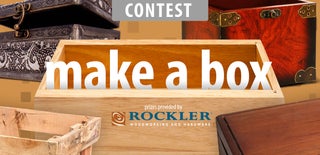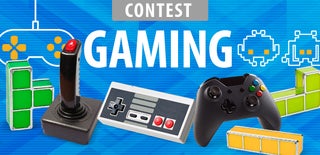Introduction: J3WL-TP: a Borderlands Claptrap Inspired Box That Holds Valuables (If You Trust Him To...)
Greetings, Traveler! Today, we are going to teach you how to build your very own J3WL-TP, or as we call him, the JewelTrap! Now, I know you're thinking, "but Escap075, how can we trust a silly Claptrap variant unit to safely store our valuable items?" Well, Let me tell you why: this JewelTrap has NO AI! It doesn't even have a computer! It's just an empty, wooden box dressed up to show your affection for the great Borderlands of Pandora! You can keep items in here without worrying that this unit will run off and sell them to buy cheap plastic Butt Stallion figurines! And you won't even need to worry about would-be thieves, 'cause they'll take one look and say, "gosh, that's just a little busted Claptrap, there can't possibly be anything of value in there ***!"
Now, let's get started!
***Escap075 is not responsible for Claptrap units suddenly developing AI or any other form of sentience and selling your valuables for cheap plastic Butt Stallion figurines, or any other (probably useless) items. Escap075 is also not responsible for would-be thieves deciding that they will waste their valuable time to check inside your J3WL-TP unit for valuable items. For a more comprehensive list of things Escap075 is not responsible for, please contact Escap075's non-responsibility hotline at [error: data corrupted].
Step 1: Tools and Materials
First, make sure you have everything you will need to build this little robo-box (ooh, ro-box! Cool name! [high fives myself])
Materials:
1/8th in thickness plywood
Primer
Paint (Yellow is the default, but feel free to customize your JewelTrap with whichever colors you want)
Yellow
White
Red
Blue
Black
Light & dark grey
Wood rectangles
Wood strips
Water bottle cap
Glue
Painter's Tape
Wood putty/filler
Tools:
Scroll Saw
Pen
Paper
Fine-grit sandpaper
Files
Hand Saw
Paint brushes
Step 2: Shapes
Use grid paper to trace the outline of each side of the claptrap unit using Gearbox's character cosplay reference image (which I've provided here, credit goes to Gearbox Software for this image). When you have the shapes traced onto the paper, put the paper over a piece of plywood and trace over the lines again, pressing firmly. Remove the sheet of paper and draw over the impressions you just drew.
Step 3: Cut the Wood
Cut out your pieces using a scroll saw. Once your pieces are cut, file down the edges to make them as straight as possible. Sand the wood with sandpaper.
Step 4: Prime and Paint
Brush primer onto the wood pieces you just cut and sanded. Allow to dry, then paint with your colors of choice. Paint your pieces white (or with your lighter color first), then use painter's tape to make the stripe. The top edge of the stripe should be approximately 2.3 cm from the top edge of each piece.
Step 5: Construct the Eye
While you are waiting for your paint layers to dry, you can start to construct other parts, such as the eye. For the eye, take a water bottle cap and cut away the outer rim, so that the smaller rim remains (cut where the red ring is shown in the third image above).
Paint the side of the remaining piece black and he interior blue, as shown. The last image shows approximately where the eye will be placed later on.
Step 6: Paint Details and Attach Eye
Use a straightedge and pencil to help you draw details on your unit. It can be as detailed as you like - you could even just keep it with yellow and white, if you want. Glue on the eye, it should be positioned approximately so that the top edge of the white stripe passes through the center of the eye. Paint the detail areas.
Step 7: Create a Shelf Holder (optional, Maybe)
On each piece, you can use wood rectangles to form "shelf holders" that you will use to put the bottom of the box in. You can do this by laying your wood piece flat so the interior side is face up. Then glue on the wood rectangle. It would be wise to glue this so that it is slightly angled towards the bottom of the piece, as the pieces will be slightly angled outward and these holders should be horizontal.
Step 8: Join the Edges
Use tape to hold the pieces together. The back of each edge should hold together. Glue from the inside. Use wood putty/filler to fill the outside edges to give a beveled appearance (I apologize for the poor image quality). When the putty has dried, sand, prime and paint it to blend it with the rest of the body.
Step 9: Add the Bottom
I used the long, rectangular basswood strips to form the bottom of the box. Measure out approximately the size of the interior - remember the sides will be sloped, so the size of the bottom piece will vary depending on how large you want it. Cut the rectangular pieces to the length you want and join them together to achieve the desired thickness. When the glue has dried and the pieces are firmly stuck together, insert your bottom inside the box and glue into place. You can use wood putty to fill in gaps at the edges, if you desire (though sanding it is somewhat difficult).
Step 10: Construct the Lid
You will construct the lid similarly to how you constructed the floor - by measuring the top opening and constructing a shape accordingly, either by joining several of the basswood strips together or just cutting the whole thing out of plywood. For my lid, I used three sections: two outer sides with the middle, slightly raised black portion.
For the black portion, i used a thin piece with a support structure underneath. The support structure allows for the side pieces to be more easily attached later.
When you have your side pieces constructed, sand, prime and paint them yellow. Then, you can join them to the central piece using glue. You can do this by laying the black portion flat and have one end of the yellow piece supported by a small object, so that the black portion will be slightly angled upward when it rests on top of your box. This doesn't just make your box more accurate, it also gives you a place where you can lift/open the top from.
Once you have both of the yellow pieces joined to he central black piece, use another thin strip of plywood to form the sides of the black piece, as shown in the images. Cut this piece to the correct size and shape, then sand, prime and paint it black. Finally, glue it into place.
You may notice I have not put a backing on the black center portion. This is so I have a place to lift the lid with my finger.
Step 11: Eye Lid and Antenna
We're almost done! The last two things are very simple.
First, we will construct the eye lid/eye flap that Claptrap units often have. Take a small wood rectangle and cut it to the right length of the small indent that's seen on the front of the Claptrap. Sand, prime and paint it. One side will be all yellow, while the underside will be yellow and grey, as shown above.
For the antennae, take long, square shaped wood piece and cut it to a shorter length. Paint it black.
Glue the eye lid and antenna into place once dry. Your may need to use objects to hold them in position while the glue dries.
Step 12: Hide Your Things!
Congratulations, you now have your very own J3WL-TP Unit to hold all of your valuables!
What can it hold?
Makeup!
Plastic Eggs!
Empty Soda cans!
Pencils!
Or even... FAKE JEWELS!!!!!! (Of course we understand if you don't trust your unit to safely and securely hold real jewels).
If it fits, it sits!
But before I leave you guys to build your own item-holding armies of pretty wooden boxes, here's a few pointers that may help you in construction:
- Use a laser cutter or CNC machine if you have one! This will save you some effort of having to file down those edges to make them straighter. Sadly I am not currently in possession of either, so I must continue to file my edges to straightness.
- Bevel the edges - using the file or an electric sander. You might not need to use any putty for those edges, and your box will be a more accurate depiction of a Claptrap unit.

Participated in the
Make a Box Contest

Participated in the
Gaming Contest

Participated in the
Full Spectrum Laser Contest 2016












